Module 9 People and places>Unit 3 Language in use.课件
文档属性
| 名称 | Module 9 People and places>Unit 3 Language in use.课件 |  | |
| 格式 | zip | ||
| 文件大小 | 5.4MB | ||
| 资源类型 | 教案 | ||
| 版本资源 | 外研版 | ||
| 科目 | 英语 | ||
| 更新时间 | 2018-01-05 12:57:22 | ||
图片预览

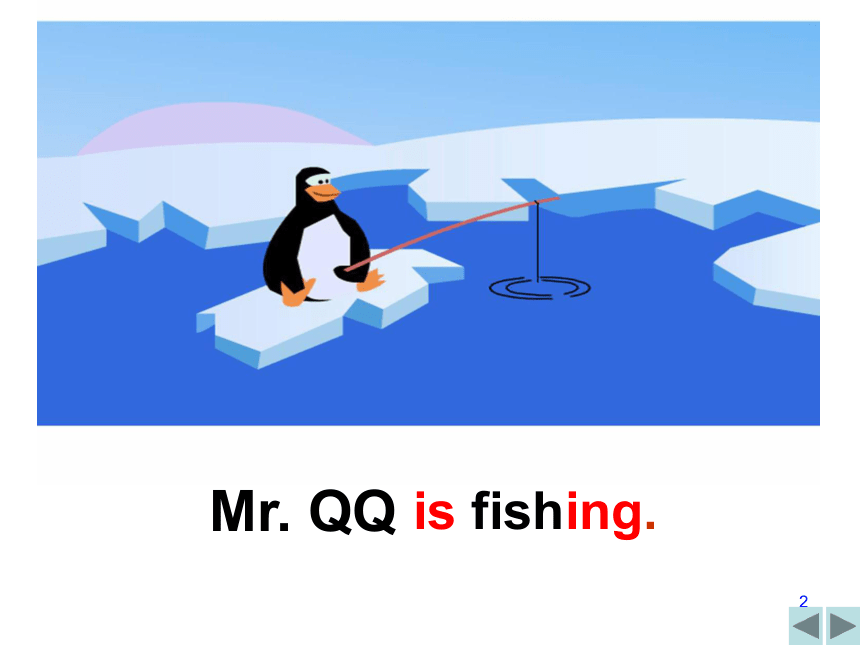
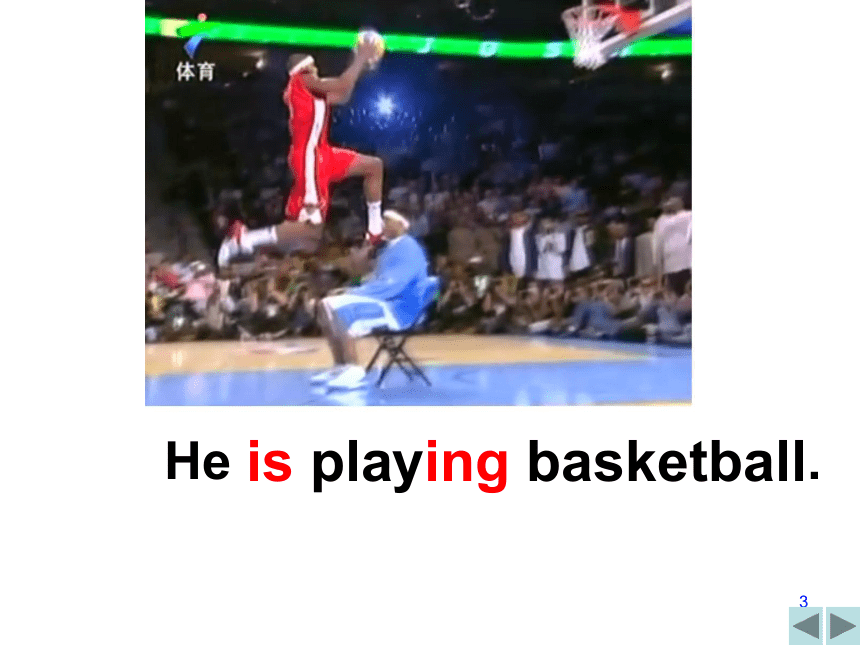
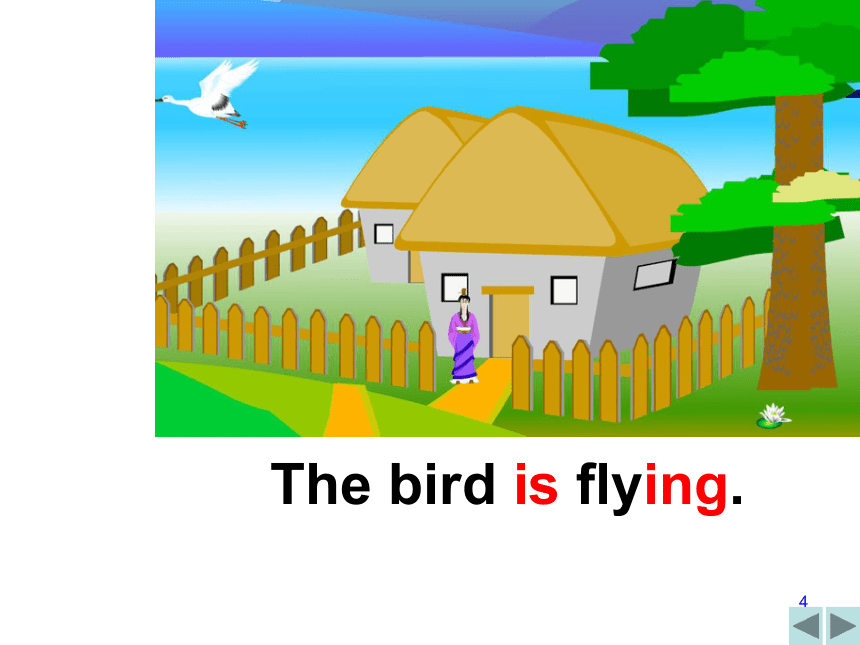


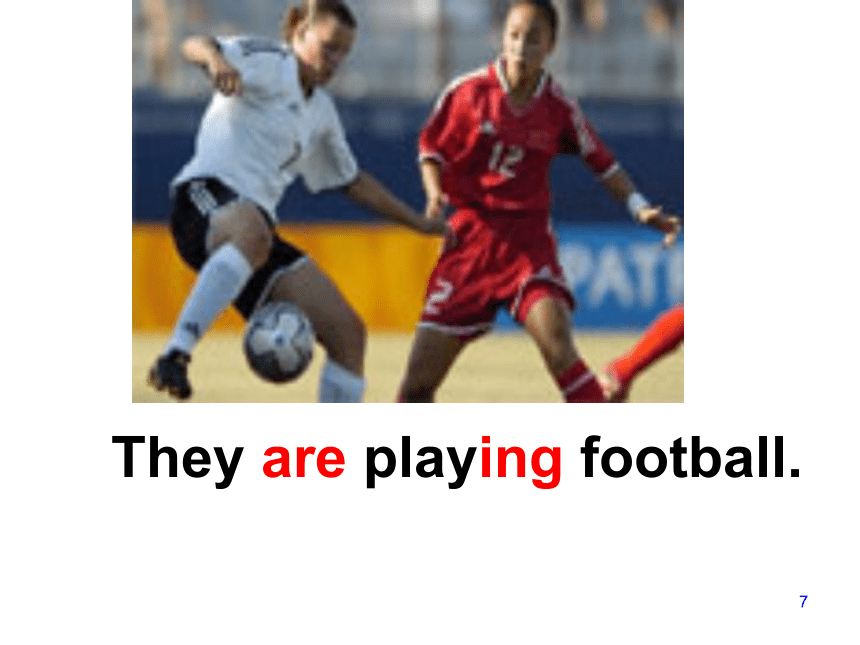
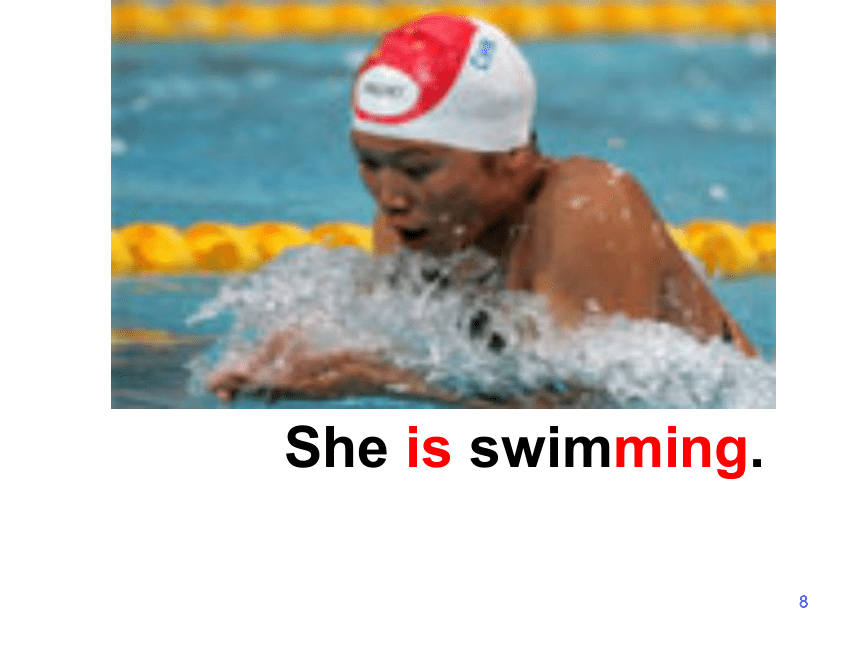
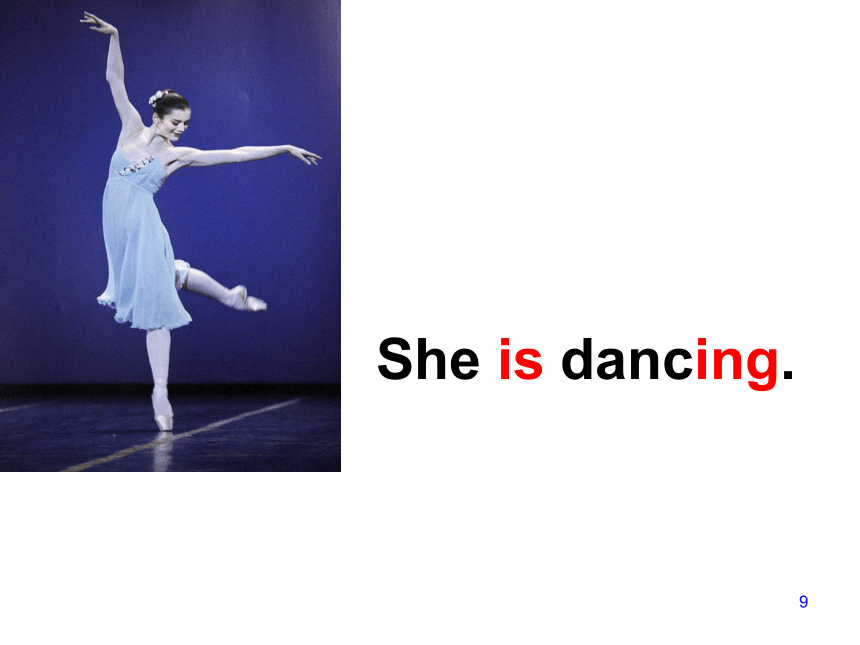
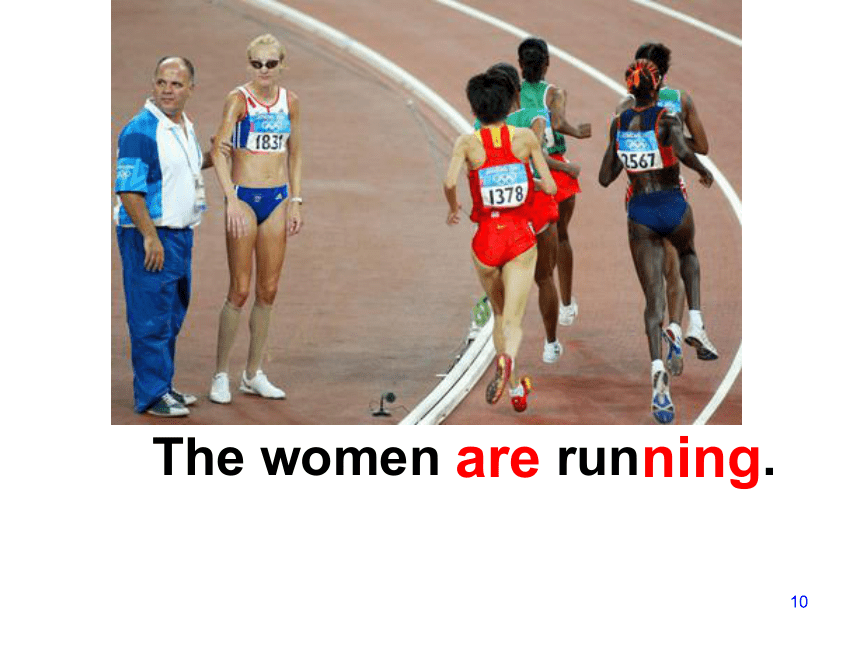

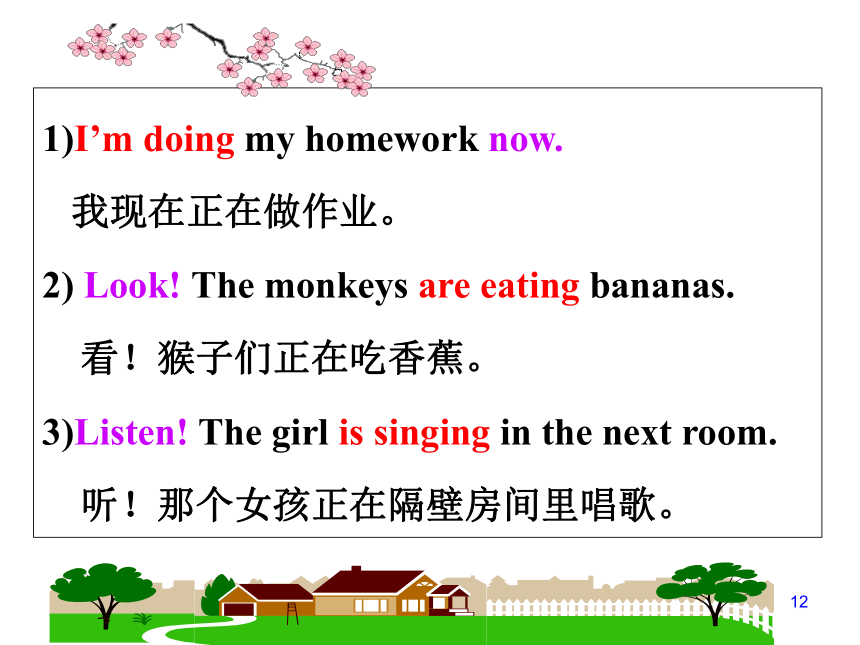
文档简介
课件32张PPT。Module 9 People and places
Grammar1Mr. QQ is fishing. 1He is playing basketball.1The bird is flying.1They are singing.1They are eating.1They are playing football.1She is swimming.1She is dancing.1The women are running.1现在进行时态定义:表示现在或现阶段正在发生的动作或
存在的状态。
2. 构成:be + 动词的现在分词。
be 随着人称、数的变化而变化(am/is/are) 。
3.标志词:现在进行时经常和时间状语now, at the moment 或look, listen等连用。11)I’m doing my homework now.
我现在正在做作业。
2) Look! The monkeys are eating bananas.
看!猴子们正在吃香蕉。
3)Listen! The girl is singing in the next room.
听!那个女孩正在隔壁房间里唱歌。14.现在分词的组成形式有如下几种:1写出下列动词的现在分词(- ing)形式talk ________ drive ________ put _______lie _________ work _______ play ________have _______ eat _________ visit _______leave ________ run _______tie_______stop _______shop _________swim ______talkingdrivingputtinglyingworkingplayinghavingeatingvisitingleavingrunningtyingstoppingshoppingswimming1
1)肯定句变否定句,要在 be 后加 not 构成
eg:We are reading English now.
?We are not reading English now.
2)陈述句变一般疑问句,把be动词提到句首
eg:The student is drinking.
? Is the student drinking?
3)陈述句变特殊疑问句,由“疑问词+一般疑问句”构成
eg:He is working. ? What is he doing?
5.现在进行时的句型转换
1 现在进行时的特殊疑问句1The girls are playing games in the playground.
1)对主语提问:
Who is playing games in the playground.
2)对谓宾提问:
What are the girls doing in the playground?
3)对宾语提问:
What are the girls playing in the playground?
4)对地点提问:
Where are the girls playing games ?16.用“现在进行时”表示将来
例:I am coming.
We are leaving tomorrow.
总结:表示“来来去去”的词,如:come go leave start move arrive fly stay等,用这些词的现在进行时表示将来的动作。11.句型转换
1. She is watching TV.(改为否定句)
She _______________ TV.
2. They are waiting for their teacher. (改为一般疑问句)
_____ they _________ for their teacher?
3. Daming is taking photos. (对画线部分提问)
___________ Daming _________?isn’t watchingArewaitingWhat’sdoingPresentation12.Complete the conversation between Tony and his dad.Tony : Hi, Dad!
Dad : Hi, Tony. What are you doing now?
Tony : We ______________(visit) the Forbidden City.
Lingling and Betty ____________ (write)
postcards.
Dad : What is Daming doing? are visitingare writing1Tony: He ___________(take) photos. There are lots of
people here. They ____________(enjoy) the sun.
Some people ____________(look) at the buildings
and some _____________(look) at maps.
Dad: Are you having a good time?
Tony: Yes, we ___________(have) a great time, Dad! See
you next Monday.is takingare enjoyingare lookingare lookingare having13.Write about the pictures.11He isn’t watching TV.
He is working on a computer.
14.Work in pairs.
driving a car
getting up
going to sleep
lying in the sun
playing basketballA:You’re running for a bus!
B:No!
A:You’re playing basketball!
B:Yes!running for a bus
studying history
taking photos
watching TV
writing postcards1单项选择
1. It’s not good to read _____ the sun.
A. under B. in C. for
2. Look, Tony _____ on the playground!
A. lying B. is lying C. is lieing
3. Lingling would like to take photos _____ the beautiful scenes (风景).
A. for B. about C. ofPractice14. Linda is _____ a bus over there.
A. waiting B. waiting for
C. waits for
5. — What _____ he _____?
— He is reading a book.
A. does; do
B. is; do
C. is; doing1Tony ________________photos.
They _______________ their teacher.
We _________________with friends.
Daming ______________ on the bed.
Lily and Tom ___________________ a good time.用动词的-ing形式填空is takingare callingare shoppingis lyingare having11. I standing on the Great Wall of China and talking to you.
I am standing on the Great Wall of China and talking to you.
2. They are wait for buses or trains now.
They are waiting for buses or trains now.
火眼金睛1用be(is, am, are) 动词的适当形式填空
1. Tony ____ eating a delicious ice cream.
2. I ____ taking a lot of photos.
3. They ____ watching TV at home.
4. Lucy and Lily ____ doing homework.
isamareare1Time and tide wait for no man.
时不我待。1Homework
Think of a friend or a member of your family who you don’t often see. Write a postcard saying what you’re doing at the moment.1
Grammar1Mr. QQ is fishing. 1He is playing basketball.1The bird is flying.1They are singing.1They are eating.1They are playing football.1She is swimming.1She is dancing.1The women are running.1现在进行时态定义:表示现在或现阶段正在发生的动作或
存在的状态。
2. 构成:be + 动词的现在分词。
be 随着人称、数的变化而变化(am/is/are) 。
3.标志词:现在进行时经常和时间状语now, at the moment 或look, listen等连用。11)I’m doing my homework now.
我现在正在做作业。
2) Look! The monkeys are eating bananas.
看!猴子们正在吃香蕉。
3)Listen! The girl is singing in the next room.
听!那个女孩正在隔壁房间里唱歌。14.现在分词的组成形式有如下几种:1写出下列动词的现在分词(- ing)形式talk ________ drive ________ put _______lie _________ work _______ play ________have _______ eat _________ visit _______leave ________ run _______tie_______stop _______shop _________swim ______talkingdrivingputtinglyingworkingplayinghavingeatingvisitingleavingrunningtyingstoppingshoppingswimming1
1)肯定句变否定句,要在 be 后加 not 构成
eg:We are reading English now.
?We are not reading English now.
2)陈述句变一般疑问句,把be动词提到句首
eg:The student is drinking.
? Is the student drinking?
3)陈述句变特殊疑问句,由“疑问词+一般疑问句”构成
eg:He is working. ? What is he doing?
5.现在进行时的句型转换
1 现在进行时的特殊疑问句1The girls are playing games in the playground.
1)对主语提问:
Who is playing games in the playground.
2)对谓宾提问:
What are the girls doing in the playground?
3)对宾语提问:
What are the girls playing in the playground?
4)对地点提问:
Where are the girls playing games ?16.用“现在进行时”表示将来
例:I am coming.
We are leaving tomorrow.
总结:表示“来来去去”的词,如:come go leave start move arrive fly stay等,用这些词的现在进行时表示将来的动作。11.句型转换
1. She is watching TV.(改为否定句)
She _______________ TV.
2. They are waiting for their teacher. (改为一般疑问句)
_____ they _________ for their teacher?
3. Daming is taking photos. (对画线部分提问)
___________ Daming _________?isn’t watchingArewaitingWhat’sdoingPresentation12.Complete the conversation between Tony and his dad.Tony : Hi, Dad!
Dad : Hi, Tony. What are you doing now?
Tony : We ______________(visit) the Forbidden City.
Lingling and Betty ____________ (write)
postcards.
Dad : What is Daming doing? are visitingare writing1Tony: He ___________(take) photos. There are lots of
people here. They ____________(enjoy) the sun.
Some people ____________(look) at the buildings
and some _____________(look) at maps.
Dad: Are you having a good time?
Tony: Yes, we ___________(have) a great time, Dad! See
you next Monday.is takingare enjoyingare lookingare lookingare having13.Write about the pictures.11He isn’t watching TV.
He is working on a computer.
14.Work in pairs.
driving a car
getting up
going to sleep
lying in the sun
playing basketballA:You’re running for a bus!
B:No!
A:You’re playing basketball!
B:Yes!running for a bus
studying history
taking photos
watching TV
writing postcards1单项选择
1. It’s not good to read _____ the sun.
A. under B. in C. for
2. Look, Tony _____ on the playground!
A. lying B. is lying C. is lieing
3. Lingling would like to take photos _____ the beautiful scenes (风景).
A. for B. about C. ofPractice14. Linda is _____ a bus over there.
A. waiting B. waiting for
C. waits for
5. — What _____ he _____?
— He is reading a book.
A. does; do
B. is; do
C. is; doing1Tony ________________photos.
They _______________ their teacher.
We _________________with friends.
Daming ______________ on the bed.
Lily and Tom ___________________ a good time.用动词的-ing形式填空is takingare callingare shoppingis lyingare having11. I standing on the Great Wall of China and talking to you.
I am standing on the Great Wall of China and talking to you.
2. They are wait for buses or trains now.
They are waiting for buses or trains now.
火眼金睛1用be(is, am, are) 动词的适当形式填空
1. Tony ____ eating a delicious ice cream.
2. I ____ taking a lot of photos.
3. They ____ watching TV at home.
4. Lucy and Lily ____ doing homework.
isamareare1Time and tide wait for no man.
时不我待。1Homework
Think of a friend or a member of your family who you don’t often see. Write a postcard saying what you’re doing at the moment.1
同课章节目录
- Starte
- Module 1 My teacher and my friends
- Module 2 My English lesson
- Module 3 My English book
- Module 4 My everyday life
- Module 1 My classmates
- Unit 1 Nice to meet you.
- Unit 2 I'm Wang Lingling and I'm thirteen years ol
- Unit 3 Language in use.
- Module 2 My family
- Unit 1 Is this your mum?
- Unit 2 These are my parents.
- Unit 3 Language in use.
- Module 3 My school
- Unit 1 There are thirty students in my class.
- Unit 2 The library is on the left of the playgroun
- Unit 3 Language in use.
- Module 4 Healthy food
- Unit 1 We've got lots of apples.
- Unit 2 Is your food and drink healthy?
- Unit 3 Language in use.
- Module 5 My school day
- Unit 1 I love history.
- Unit 2 We start work at nine o'clock.
- Unit 3 Language in use.
- Revision module A
- Module 6 A trip to the zoo
- Unit 1 Does it eat meat?
- Unit 2 The tiger lives in Asia.
- Unit 3 Language in use.
- Module 7 Computers
- Unit 1 How do I write my homework on the computer?
- Unit 2 When do you use a computer?
- Unit 3 Language in use.
- Module 8 Choosing presents
- Unit 1 I always like birthday parties.
- Unit 2 She often goes to concerts.
- Unit 3 Language in use.
- Module 9 People and places
- Unit 1 We're enjoying the school trip a lot.
- Unit 2 They're waiting for buses or trains.
- Unit 3 Language in use.
- Module 10 Spring Festival
- Unit 1 Are you getting ready for Spring Festival?
- Unit 2 My mother's cleaning our houses and sweepin
- Unit 3 Language in use.
- Revision module B
